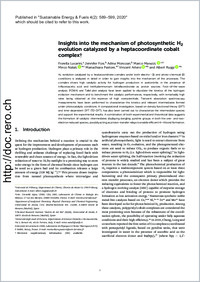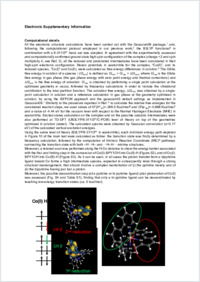Insights into the mechanism of photosynthetic H 2 evolution catalyzed by a heptacoordinate cobalt complex
- Lucarini, Fiorella Université de Fribourg - Département de Chimie - 1700 Fribourg - Switzerland
- Fize, Jennifer Univ. Grenoble Alpes - CNRS - CEA - IRIG - Laboratoire de Chimie et Biologie des Métaux
- Morozan, Adina Univ. Grenoble Alpes - CNRS - CEA - IRIG - Laboratoire de Chimie et Biologie des Métaux
- Marazzi, Marco Department of Analytical Chemistry, Physical Chemistry and Chemical Engineering - Universidad de Alcalá - E-28805 Alcalá de Henares (Madrid) - Spain - Chemical Research Institute “Andrés M. del Río” (IQAR)
- Natali, Mirco Università degli studi di Ferrara - Dipartimento di Scienze Chimiche e Farmaceutiche - 44121 Ferrara - Italy
- Pastore, Mariachiara Université de Lorraine & CNRS - Laboratoire de Physique et Chimie Théoriques (LPCT) - Nancy - France
- Artero, Vincent Univ. Grenoble Alpes - CNRS - CEA - IRIG - Laboratoire de Chimie et Biologie des Métaux
- Ruggi, Albert Université de Fribourg - Département de Chimie - 1700 Fribourg - Switzerland
-
26.11.2019
Published in:
- Sustainable Energy & Fuels. - 2020, vol. 4, no. 2, p. 589–599
English
H2 evolution catalyzed by a heptacoordinate complex under both electro- (1) and photo-chemical (2) conditions is analyzed in detail in order to gain insights into the mechanism of the processes. The complex shows high catalytic activity for hydrogen production in acetonitrile, in the presence of trifluoroacetic acid and triethylammonium tetrafluoroborate as proton sources. Foot-of-the-wave analysis (FOWA) and Tafel plot analysis have been applied to elucidate the kinetics of the hydrogen evolution mechanism and to benchmark the catalytic performances, respectively, with remarkably high rates being obtained at the expense of high overpotentials. Transient absorption spectroscopy measurements have been performed to characterize the kinetics and relevant intermediates formed under photocatalytic conditions. A computational investigation, based on density functional theory (DFT) and time- dependent DFT (TD-DFT), has also been carried out to characterize the intermediate species and support the experimental results. A combination of both experimental and theoretical data suggests the formation of catalytic intermediates displaying dangling pyridine groups in both the one- and two-electron reduced species, possibly acting as proton-transfer relays to enable efficient H–H bond formation.
- Faculty
- Faculté des sciences et de médecine
- Department
- Département de Chimie
- Language
-
- English
- Classification
- Chemistry
- License
- License undefined
- Identifiers
-
- RERO DOC 329952
- DOI 10.1039/C9SE00434C
- Persistent URL
- https://folia.unifr.ch/unifr/documents/309130
Other files
Statistics
Document views: 78
File downloads:
- luc_iim.pdf: 94
- luc_iim_sm.pdf: 64

